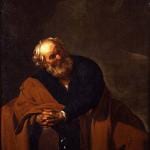
Last night I watched a fascinating documentary through Amazon Prime: a NOVA episode entitled “Einstein’s Quantum Riddle”. It was about advances in the area of quantum mechanics; specifically what is called “quantum entanglement.” Wikipedia has a long, complicated article about it. But the gist of it (which the TV special summarized for the layperson) is as follows:
Quantum entanglement is a physical phenomenon that occurs when a pair or group of particles are generated, interact, or share spatial proximity in a way such that the quantum state of each particle of the pair or group cannot be described independently of the state of the others, including when the particles are separated by a large distance. . . .
Such phenomena were the subject of a 1935 paper by Albert Einstein, Boris Podolsky, and Nathan Rosen,[1] and several papers by Erwin Schrödinger shortly thereafter,[2][3] describing what came to be known as the EPR paradox. Einstein and others considered such behavior to be impossible, as it violated the local realism view of causality (Einstein referring to it as “spooky action at a distance“)[4] and argued that the accepted formulation of quantum mechanics must therefore be incomplete.
Later, however, the counterintuitive predictions of quantum mechanics were verified experimentally[5][6][7] in tests in which polarization or spin of entangled particles were measured at separate locations, statistically violating Bell’s inequality. In earlier tests, it couldn’t be absolutely ruled out that the test result at one point could have been subtly transmitted to the remote point, affecting the outcome at the second location.[7] However, so-called “loophole-free” Bell tests have been performed in which the locations were separated such that communications at the speed of light would have taken longer–in one case 10,000 times longer—than the interval between the measurements. . . .
Quantum entanglement has been demonstrated experimentally with photons,[10][11 ]neutrinos,[12] electrons,[13][14] molecules as large as buckyballs, [15][16] and even small diamonds. [17][18]
Bottom line (beyond all the technical mumbo-jumbo of modern physics), is that — even assuming that this phenomenon is true and a fact — scientists have no explanation for how it could happen as it does. It’s one of those things where the knowledge of science comes to an end: like the origin of life, the causes of the origins of the Big Bang, DNA, and higher intelligence, and dark matter.
Einstein, as is well-known, had serious problems with quantum mechanics, with regard to its seemingly random and irrational nature, in relation to traditional notions of cause-and-effect. He famously stated, “God doesn’t play dice.” Einstein’s “god” was a pantheist one at best, but he was no atheist, and recognized that the universe had an unexplainable higher order and beauty of design that any thinking person couldn’t deny. I have argued that this was a broad, bare-bones version of the classic theistic teleological (design) argument.
This brings me in a roundabout way to my main point: science often gets to a place where it is completely baffled, but because it methodologically excludes God (which has essentially been the case since Darwin), and so often doesn’t recognize its own inherent philosophical limitations (empiricism being only one form of knowledge among many), it rules out what is as plausible an explanation as anything else: God.
The most obvious example of this is Big Bang cosmology. This theory was formulated by a Catholic priest-scientist, Fr. Georges Lemaître. It expressed in scientific detail what had already long since been present in the Bible: creatio ex nihilo (“creation from nothing”). I’ve written many times about the Big Bang theory and its relation to God:
Atheism: the Faith of “Atomism” [8-19-15]
Cosmological Argument for God (Resources) [10-23-15]
*
Dr. [Michael] Behe stated that Intelligent Design (ID) did not necessarily require additional “intervention” by God after His initial act of creation. I found that interesting because I had thought that ID required that.
All Christians, it seems to me (who believe in the inspiration of revelation: the Bible), have to believe that 1) God created (Genesis, etc.), and 2) that God in some sense “sustains” or “upholds” His creation, according to Hebrews 1:3 (“upholding the universe by his word of power”: RSV) and Acts 17:28 (“In him we live and move and have our being”). . . .
[It is a] belief in a non-material or immaterial force or power or spirit, if you will, that profoundly influences the material universe and its creative processes, and which itself seems ultimately beyond purely scientific or empirical analysis (precisely because it is non-material). . . .
[I]n this view, which can be synthesized with Intelligent Design (and is similar in many ways to theistic evolution), God designed or foreordained that complex structures would evolve, and life and consciousness, etc., by some unknown non-material, overarching, guiding principle that transcends science, or concerning which science can give us no clues or answers. He not only created scientific laws that work essentially on their own (hence can be observed and studied scientifically), but also “supervises” or ordains the entire “project”: though not in an interventionist or supernatural / miraculous way. The processes and potentialities were there from the beginning, as a manifestation of His omnipotence and omniscience. It’s just that some of them are supra-scientific.
I submit that the same explanation that suggests itself with regard to the Big Bang and the unexplained mysteries of evolutionary process: the creative and “upholding” / omnipotent power of God, is applicable and plausible also as the explanation of how quantum entanglement is possible at all. I mentioned a relevant few verses above. Here are all of the ones along these same lines:
Job 38:33 (RSV) Do you know the ordinances of the heavens? Can you establish their rule on the earth?
Nehemiah 9:6 . . . “Thou art the LORD, thou alone; thou hast made heaven, the heaven of heavens, with all their host, the earth and all that is on it, the seas and all that is in them; and thou preservest all of them; . . .”
Wisdom 11:25 How would anything have endured if thou hadst not willed it? Or how would anything not called forth by thee have been preserved?
Acts 17:28 . . . ‘In him we live and move and have our being’;
Colossians 1:17 . . . in him all things hold together.
Hebrews 1:3 . . . upholding the universe by his word of power . . .
This is inspired revelation from God. God either does these things: establishes, preserves, holds together, allows to endure, and upholds all of His creation (which He brought into being from nothing) or He does not. Christians — if they are consistent — cannot disbelieve this. And God’s power is as plausible an explanation of quantum entanglement as anything else: if only “methodologically atheist” science will allow Him to be discussed at all.
If scientists seek the vaunted “unified theory” in physics, it’s right in front of them: the central unifying, overarching factor or cause is God Himself. The Bible has taught it these past 2000 or more years. Modern science keeps indirectly verifying it, in effect, by its inability to explain origins or (as in our present example) the basis and ultimate causes of experimentally verified quantum mechanics.
***
Photo credit: sciencefreak (1-20-15) [Pixabay / Pixabay License]
***












